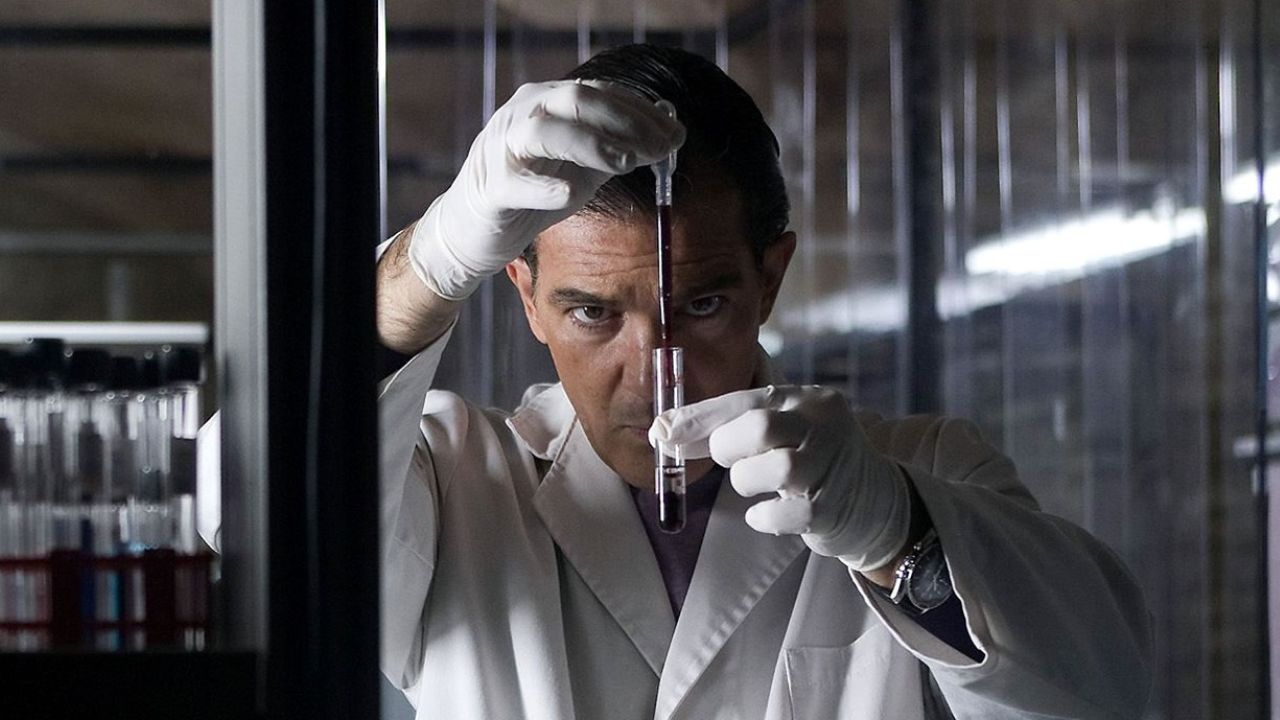This post includes a character analysis of Robert Ledgard, the main antagonist of the 2011 film “The Skin I Live In”. Beware of spoilers.
Directed by Pedro Almodóvar, the 2011 psychological thriller stars Antonio Banderas as Robert Ledgard.
The Skin I Live In
In “The Skin I Live In”, Robert Ledgard is a prominent plastic surgeon. His latest research revolves around creating a new skin that can resist any damage. Gal, who is Robert’s wife, suffered severe burns in a car accident, she is the main influence behind his work.
After losing his wife, Robert loses his daughter (Norma) too. The young woman killed herself after being sexually assaulted. To avenge Norma’s death, Robert goes after a young man named Vicente. After kidnapping his target, he holds Vicente captive at his house.
To punish Norma’s perpetrator, Robert performs a series of surgeries on Vicente, including a sex change operation. Robert even gives Vicente the face and body of Gal and renames him Vera. The latter is also used as a guinea pig for Robert’s experiments on artificial skin.
Robert keeps Vera under constant surveillance and control but gradually develops an attraction to her. One day, Zeca, who is the housekeeper’s son and Robert’s half-brother, sneaks into the plastic surgeon’s house and rapes Vera, mistaking her for Gal. After finding him in Vera’s room, Robert shoots Zeca dead.
The incident creates a new relationship dynamic between captor and captive. Vera uses her charm and resemblance to Gal to manipulate Robert. Meanwhile, Marilia, who is also the plastic surgeon’s biological mother, tries to warn him about Vera’s deception, but he ignores her.
After Vera gets her hands on Robert’s gun, she shoots her captor dead. Then she kills Marilia too. Vera manages to finally leave the house and escape her captor. As she returns to her mother’s dress shop, the latter looks at Vera in disbelief.
Note: For those who are interested, here is another article discussing the meaning behind the ending of “The Skin I Live In”.
Robert Ledgard Character Analysis in “The Skin I Live In”
“The Skin I Live In” presents Robert Ledgard as a plastic surgeon and a researcher. His latest experiments involve developing a resistant artificial skin. Despite his successful career, a tragic past haunts Robert and he also has a couple of secrets of his own.
In terms of personality, Robert Ledgard is brilliant, complex and twisted. As an ambitious scientist, Robert broke many ethical and legal boundaries to achieve his goals. The man is obsessed with his wife, Gal. Even after she died, Robert tried to “recreate her” in Vera. In the end, love, guilt and revenge drove the man into a downward spiral.

What motivates Robert Ledgard’s actions in “The Skin I Live In”?
Robert Ledgard’s actions in “The Skin I Live” are mainly motivated by his personal tragedies. In his case, the suicides of Gal and Norma had a very negative impact on him. Robert loved his wife, who committed suicide because she could not stand to look at herself after her horrific car accident. At the time, Robert felt tremendous guilt for not being able to save her or prevent her death.
The second tragedy in Robert Ledgard’s life was definitely the passing of his daughter, Norma. The young woman suffered a mental breakdown after meeting Vicente on that fateful night. She genuinely believed the young man forced himself on her, which took a toll on her mental health. Ultimately, Norma decided to put an end to her suffering by killing herself.
These two tragedies together led Robert Ledgard to kidnap Vicente and change his appearance and gender without the latter’s consent. Keeping Vera captive and alive was his way of dealing with his grief and obsession.
Robert Ledgard’s Character Evolution
As the story of “The Skin I Live In” unfolds, the antagonist and his personality go through some significant changes. Robert Ledgard changes from a ruthless and cruel captor to a vulnerable and desperate lover. In the end, the man ultimately loses everything he has created.
After kidnapping Vicente, Robert Ledgard transformed him into a woman who resembled his late wife. In other words, Vera is a physical replica of Gal. Later on, Robert even showed a “warmer” side to Vera, which was very different from his initial cold attitude towards his “creation”.
Robert Ledgard and Themes of “The Skin I Live In”
“The Skin I Live In” is a film that explores the themes of identity, obsession and revenge. When Robert Ledgard kidnapped Vicente, he transformed his captive into someone to whom he did not consent. In a way, Robert tried to erase Vicente’s identity. The plastic surgeon was trying to shape the young man into a replica of his wife, whom he still loved.
Obsession is another central theme in “The Skin I Live In”. Robert Ledgard has a rather unhealthy obsession with his work, and that also includes “Vera”. All the experiments he performed on his human guinea pig were illegal, not to mention unethical, but Robert does not seem to care. Even after her death, Robert is still obsessed with his wife.
Lastly, revenge is another major theme that drives the plot of “The Skin I Live In”. The desire for revenge blinds Robert Ledgard and drives him to do the unthinkable. He wants to punish those who wrong him and that is how Robert justifies his cruel actions.

Final Thoughts
Robert Ledgard is ultimately a tragic figure who pays a high price for his actions. He is not a real villain in the film, but more of a victim of his personal tragedies. The man lost his wife and daughter in horrific circumstances, and he could not cope with the pain and grief.
Although Robert Ledgard’s actions are inexcusable and monstrous, they are also understandable and pitiful. In many ways, his crimes were driven by love and despair. After being in a dark place for a long time, Robert did not care about the consequences of his actions.
In the process of getting revenge, Robert ended up losing his humanity and sanity. The pain of losing his loved ones blinded him and led him to disregard Vicente’s human rights and dignity. Even though the latter is not necessarily innocent, he deserved the right to a fair trial for his “alleged” crime.
“The Skin I Live In” shows how pain and grief can strip people of their rationality and compassion, leading them to commit horrible crimes. It’s easy to pin Robert Ledgard as a villain. But in reality, he is more of a flawed and broken human being who tried to find solace in his madness. Robert Ledgard is a complex character who deserves both condemnation and sympathy.


